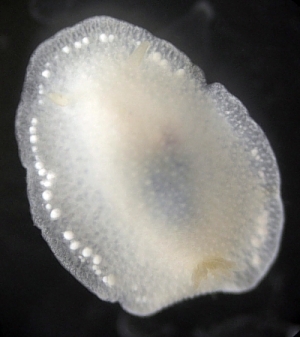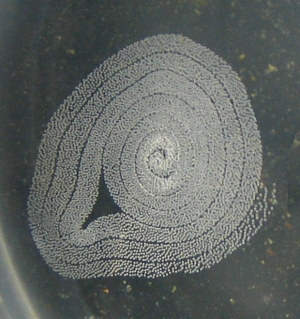

Conualevia alba
Collier and Farmer, 1964
Order: NUDIBRANCHIA
Suborder: DORIDINA
Superfamily: EUDORIDOIDEA
Family: Conualevidae
DISTRIBUTION
Eastern Pacific from from Monterey, California south to the Galapagos Islands.
PHOTO
Locality: Monterey, 7 m, California, USA, Pacific Ocean, October 2006, subtidal. Length: 11 mm. Photographer: Jeff Goddard.
This species ranges from Monterey, California, south to the Galapagos Islands, and is usually found under rocks, where it preys on unidentified demosponges (personal observations). It has smooth, tapering rhinophores, small, evenly spaced notal papillae, and large white defensive glands around the notal margin. Like some other dorids consistently found feeding under rocks (e.g. Crimora coneja and Limacia cockerelli), it lays its thin egg ribbon flat, rather than on edge like most other dorids. The eggs averaged about 89 microns in diameter and hatched as typical planktotrophic veligers with shells about 150 microns long.
-
Behrens, D. W. & A. Hermosillo. (2005). Eastern Pacific nudibranchs. Sea Challengers, Monterey, California
-
Collier, C. L. & W. M. Farmer. (1964). Additions to the nudibranch fauna of the east Pacific and the Gulf of California. Transactions of the San Diego Natural History Society, 13, 377-396.
-
Camacho-Garcia, Y., T. M. Gosliner & A. Valdes. (2005). Field Guide to the sea slugs of the tropical eastern Pacific. California Academy of Sciences, San Francisco, California.
Goddard, J.H.R., 2007 (March 21) Conualevia alba Collier and Farmer, 1964 . [In] Sea Slug Forum. Australian Museum, Sydney. Available from http://www.seaslugforum.net/factsheet/conualba
Related messages
-
Elongate polar bodies of Conualevia alba
From: Jeff Goddard, March 22, 2007 -
Conualevia alba from Monterey, California
From: Jeff Goddard, March 22, 2007
